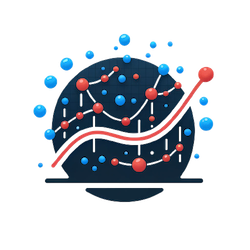Object tracking#
[1]:
import jax
import jax.numpy as jnp
import matplotlib.pyplot as plt
import matplotlib as mpl
import numpy as np
from filterjax import KalmanFilter, plot_posterior_covariance
plt.style.use("../styles.mplstyle")
%load_ext autoreload
%autoreload 2
One dimension#
This simulated problem is taken from Kalman and Bayesian filters in Python by Roger Labbe. The problem is to track a dog in a hallway. The dog is wearing an RFID tag and there is a sensor at the left end of the hallway. The sensor returns the distance of the dog from the left end of the hallway in meters. So, 23.4 would mean the dog is 23.4 meters from the left end of the hallway.
[26]:
class DogSensor:
def __init__(self, key, x0=0, velocity=1, noise=0.0):
self.key = key
self.x = jnp.array(x0)
self.velocity = jnp.array(velocity)
self.noise = jnp.sqrt(noise)
def sense(self, shape: tuple = (1,)):
x = []
for _ in range(shape[0]):
self.x += self.velocity
x.append(self.x)
return jnp.array(x) + jax.random.normal(self.key, shape) * self.noise
[40]:
key = jax.random.PRNGKey(0)
movement = 1
sensor_error = 10
pos = (0, 500)
dog = DogSensor(key, x0=pos[0], velocity=movement, noise=sensor_error)
emissions = dog.sense((50,))
[41]:
plt.figure(figsize=(7, 3))
plt.scatter(jnp.arange(50), emissions, alpha=0.5)
plt.ylabel("Meters from left end of hallway")
plt.xlabel("Measurement number")
plt.title("Dog position over time");
[42]:
def Q_DWPA(dim, dt=1., sigma=1.):
assert dim == 2 or dim == 3
if dim == 2:
Q = jnp.array([[.25*dt**4, .5*dt**3],
[ .5*dt**3, dt**2]], dtype=float)
else:
Q = jnp.array([[.25*dt**4, .5*dt**3, .5*dt**2],
[ .5*dt**3, dt**2, dt],
[ .5*dt**2, dt, 1]], dtype=float)
return Q * sigma
[43]:
F = jnp.array([[1, 1], [0, 1]])
H = jnp.array([[1, 0]])
Q = Q_DWPA(2, sigma=0.)
R = jnp.eye(1) * 5
P = jnp.eye(2) * 500.
m = jnp.array([0., 0.])
[44]:
kf = KalmanFilter(state_dim=2, emission_dim=1)
params = kf.initialize(m, F, H, R, Q, P)
posterior = kf.filter(params, emissions)
[45]:
posterior.marginal_log_likelihood
[45]:
Array(-127.903404, dtype=float32)
[46]:
fig, ax = plt.subplots(1, 2, figsize=(12, 4))
ax[0].scatter(jnp.arange(50), emissions, alpha=0.5, label="Emissions")
ax[0].plot(jnp.arange(50), posterior.mean[:, 0], linestyle="--", color="black", label="Filter mean position")
ax[0].set_ylabel("Meters from left end of hallway")
ax[0].set_xlabel("Measurement number")
ax[0].set_title("Dog position over time")
ax[0].legend()
ax[1].plot(jnp.arange(50), posterior.mean[:, 1], color="black", label="Filter mean velocity")
ax[1].set_ylabel("Mean velocity")
ax[1].set_xlabel("Measurement number")
ax[1].set_title("Dog velocity over time")
ax[1].legend();
Two dimensions#
[47]:
class PositionSensor:
def __init__(self, pos=[0, 0], vel=(0, 0), noise=1.):
self.pos = pos
self.vel = vel
self.noise = noise
def read(self):
self.pos[0] += self.vel[0]
self.pos[1] += self.vel[1]
return [self.pos[0] + np.random.randn() * self.noise,
self.pos[1] + np.random.randn() * self.noise]
[48]:
ps = PositionSensor([4, 3], (2, 1), 1)
emissions = jnp.array([ps.read() for _ in range(15)])
plt.figure(figsize=(7, 3))
plt.scatter(emissions[:, 0], emissions[:, 1], alpha=0.5, label="Emissions")
plt.xlabel("X-coordinate")
plt.ylabel("Y-coordinate")
plt.title("Dog position on x-y plane")
plt.legend();
Design the Kalman Filter#
Step 1. Choose the state variables#
Since we are tracking in two dimensions and have a sensor that returns a measurement in each of the two coordindates (\(x-y\) plane), we have two observed variables \(x\) and \(y\). However, we now have two unobserved variables where the unobserved variables are the velocity of the \(x\) and \(y\) states.
[49]:
m = jnp.array([0, 0, 0, 0], dtype=jnp.float32)
m
[49]:
Array([0., 0., 0., 0.], dtype=float32)
Step 2. Design the state transition matrix#
The state transition matrix is the matrix that we multiply with the previous state of the system to get the next state.
[50]:
# assume measurement every seoncd
dt = 1.
F = jnp.array([
[1., dt, 0, 0],
[0, 1., 0, 0],
[0, 0, 1., dt],
[0, 0, 0, 1.]
])
F
[50]:
Array([[1., 1., 0., 0.],
[0., 1., 0., 0.],
[0., 0., 1., 1.],
[0., 0., 0., 1.]], dtype=float32)
Step 3: Design the motion function#
There are no control inputs, so we can set this term to zero. Default is zero.
Step 4: Design the measurement function#
The measurement function \(\mathbf{H}\) defines how we go from the state variables to the measurements. This function is needed because with the Kalman Filter, we go from measurements to state variables. However, the update step needs to compute the residual between the current measurement and the measurement represented by the prediction step. Therefore, \(\mathbf{H}\) is multiplied by the state \(x\) to produce a measurement \(z\)
Since the state and measurement are both positions, \((x, y)\), we don’t need to do any converting here.
[51]:
H = jnp.array([
[1., 0, 0, 0],
[0, 0, 1., 0]
])
H
[51]:
Array([[1., 0., 0., 0.],
[0., 0., 1., 0.]], dtype=float32)
Step 5: Design the measurement noise matrix#
The measurement noise matrix models the noise in the sensor’s measurements.
[52]:
R = jnp.array([
[5, 0],
[0, 5]
])
R
[52]:
Array([[5, 0],
[0, 5]], dtype=int32)
Step 6: Design the process noise matrix#
The process noise matrix models the process (). This is the noise that is added to the state variables at each time step.
[53]:
Q = jnp.eye(4) * 0.1
Q
[53]:
Array([[0.1, 0. , 0. , 0. ],
[0. , 0.1, 0. , 0. ],
[0. , 0. , 0.1, 0. ],
[0. , 0. , 0. , 0.1]], dtype=float32)
Step 7: Set initial conditions#
[54]:
P = jnp.eye(4) * 100
P
[54]:
Array([[100., 0., 0., 0.],
[ 0., 100., 0., 0.],
[ 0., 0., 100., 0.],
[ 0., 0., 0., 100.]], dtype=float32)
Kalman filter implementation#
[55]:
kf = KalmanFilter(state_dim=4., emission_dim=2.)
params = kf.initialize(m, F, H, R, Q, P)
posterior = kf.filter(params, emissions)
[56]:
posterior.marginal_log_likelihood
[56]:
Array(-68.54703, dtype=float32)
Plotting filter results#
Plot posterior state mean and covariance#
[57]:
fig, ax = plt.subplots(1, 2, figsize=(12, 4))
# posterior.mean --> [x, vx, y, vy]
ax[0].scatter(
emissions[:, 0], emissions[:, 1],
alpha=0.75, label="emissions"
)
ax[0].plot(
posterior.mean[:, 0], posterior.mean[:, 2],
linestyle="--", color="black",
label="filter"
)
ax[0].set_xlabel("X-coordinate")
ax[0].set_ylabel("Y-coordinate")
ax[0].set_title("Tracking a 2d object")
ax[0].legend()
# posterior.covariance
xy_cov = []
for cov in posterior.covariance:
xy_cov.append(
jnp.array(
[[cov[0, 0], cov[0, 2]],
[cov[2, 0], cov[2, 2]]]
)
)
xy_cov = jnp.array(xy_cov)
ax[1].plot(
posterior.mean[1:, 0], posterior.mean[1:, 2],
linestyle="--", color="black",
label="filter"
)
ax[1] = plot_posterior_covariance(
posterior.mean[1:, [0, 2]],
xy_cov[1:],
ax=ax[1],
legend_kwargs={"label": "covariance"}
)
ax[1].set_xlabel("X-coordinate")
ax[1].set_ylabel("Y-coordinate")
ax[1].set_title("Tracking a 2d object");
ax[1].legend();
